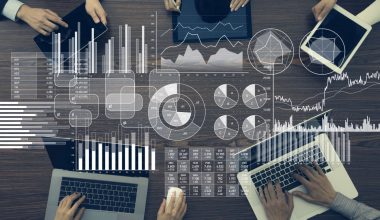Big data is a term used to describe the large amounts of organized and unstructured data that businesses have to deal with every day. But what companies do with the data is more important than the type or amount of data they have. Big data can be analyzed to find insights that help you make better business choices and give you the confidence to make strategic moves. In this article, we will explain what big data is, big data analytics, technology, healthcare, and big data engineering.
What Is Big Data
This is a collection of structured, semi-structured, and unstructured data that businesses collect. This data can be mined for information and used in machine learning projects, predictive modeling, and other uses of advanced analytics.
Big data processing and storage systems are now a regular part of organizations’ data management architectures, along with tools that help with big data analytics. The three V’s are often used to describe big data:
- the large volume of data available in many places;
- a wide variety of data types that are often stored in big data systems; and
- the velocity at which a lot of data is made, received, and processed.
Doug Laney, an analyst at the consulting company Meta Group Inc. at the time, was the first person to notice these traits in 2001. After Gartner bought Meta Group in 2005, they became even more well-known. More recently, veracity, worth, and variability have been added to different descriptions of “big data.”
Why Is Big Data Important?
Companies use big data in their systems to improve operations, give better customer service, make personalized marketing campaigns, and do other things that, in the end, can increase income and profits. Businesses that use it well may have an edge over those that don’t because they can make business decisions faster and with more information.
For example, big data gives companies useful information about their customers that they can use to improve their marketing, advertising, and deals to get more customers interested and increase sales. You can figure out how the tastes of customers or business buyers are changing by looking at data from the past and the present. This lets businesses be more responsive to what customers want and need.
Medical experts use big data to look for signs and risk factors of diseases, and doctors use it to help them figure out what’s wrong with their patients. Also, healthcare groups and government agencies can get up-to-date information about infectious disease threats or outbreaks from a mix of data from electronic health records, social media sites, the web, and other sources.
Read Also: WHAT ARE DATA STRUCTURES: Definition, Types & All To Know
What Is Big Data Analytics
Big data analytics is the act of collecting, reviewing, and analyzing massive amounts of data in order to find market trends, insights, and patterns that can help businesses make better business decisions. This information is easy to find and easy to use, so businesses can make plans quickly to keep their competitive advantage.
Tools and systems for business intelligence (BI) help groups combine structured and unstructured data from different sources. Users (usually workers) put questions into these tools to learn about how the business works and how well it is doing. Big data analytics employs the four data analysis approaches to uncover relevant insights and derive solutions.
Example of Big Data Analytics
For example, modern healthcare businesses can’t do without big data analytics. As you might guess, there are a lot of patient records, insurance plans, medications, and information about vaccines to keep track of. It has a huge amount of both organized and unstructured data, which, when used with analytics, can give us important insights. Big data analytics does this quickly and well so that doctors can use the data to make accurate predictions that could save lives.
Why Is Big Data Analytics Important?
Big data analytics is important because it allows businesses to use their data to find ways to improve. Increasing efficiency in different parts of a business leads to smarter operations, better profits, and happy customers. Big data analytics helps companies cut costs and make better goods and services that focus on the customer.
Data analytics helps us learn things that make our society work better. Big data analytics in health care not only tracks and analyzes individual records, but also plays an important role in monitoring COVID-19 outcomes on a worldwide scale. It tells the health departments of each country how to handle vaccinations and comes up with ways to stop pandemics from happening in the future.
Read Also: A Perfect Combination of Big Data and Real Estate
What Is Big Data Technology
Big data technology is a software utility. This technology is mostly made to analyze, process, and pull information from a huge set of very complicated structures and a large set of data. The old ways of handling information have a hard time dealing with this.
Big data technologies are often linked to other technologies like deep learning, machine learning, artificial intelligence (AI), and the Internet of Things (IoT), which are all greatly improved by them. When these technologies are used together, big data technologies focus on studying and managing large amounts of real-time and batch-related data.
Types of Big Data Technology
Before we get to the list of big data technologies, let’s talk about how this technology functions on the board. There are two primary types of Big Data technologies:
#1. Operational Big Data Technologies
This type of big data technology mainly includes the basic day-to-day data that people use to process. Daily data such as internet transactions, social media platforms, and data from a specific company or firm comprise operational-big data. Most of the time, this data is a necessity to analyze with tools that employ big data technologies. Many Analytical Big Data Technologies employ “raw data,” which is the data.
Here are some specific examples of Operational Big Data Technologies:
- Online ticket booking method for things like buses, trains, flights, movies, and more.
- Online dealing or shopping from e-commerce sites like Amazon, Flipkart, Walmart, etc.
- Online data from social networking sites like Facebook, Instagram, WhatsApp, etc.
- In multinational companies, the information about workers or top executives.
#2. Analytical Big Data Technologies
People often call Analytical Big Data an improved form of Big Data technology. Compared to operational-big data, this type of big data technology is a bit more difficult. Most of the time, analytical big data is used when performance criteria are being used and important business choices are being made in real-time based on reports made by analyzing operational-real data. This means that this form of big data technology serves to investigate large amounts of data that are critical for making business decisions.
The following are some common applications of analytical big data technologies:
- Stock marketing data
- Data on weather forecasts and time series analysis
- Doctors can keep an eye on a person’s health by looking at their medical information.
- Databases for space missions, where every bit of knowledge is very important
What Is Big Data Healthcare
Big data refers to large sets of unstructured as well as structured information that are analyzed to find ideas, trends, and patterns. Most of the time, the three V’s (volume, velocity, and variety) are used to describe big data. This means that it has a lot of data that is created quickly and comes in different forms, such as text, images, graphs, or movies.
Big data in health care comes from many different places and is studied to help make decisions, improve patient outcomes, and lower costs, among other things. Electronic health records (EHR), electronic medical records (EMR), personal health records (PHR), and data from widely used digital health tools like wearable medical devices and mobile health apps are some of the most popular sources of big data in health care.
Read Also: BIGGEST INSURANCE COMPANIES IN 2023: Top Companies in the World, Us, UK & Canada
Big Data Examples in Healthcare
Electronic health records (EHRs), which usually include a patient’s medical history, demographic information, medicines, immunizations, test results, and progress notes, maybe the most common source of big data in health care. In the past, this information was written down by hand in files that were easy to lose, hard to share, and sometimes even hard to read. Now, EHRs make it easy for doctors and nurses to find a patient’s important medical information and give them the best care possible.
Medical researchers can utilize EHR data and machine learning to anticipate complications after surgery, heart failure, and drug abuse.
Big Data Applications in Healthcare
Professionals in health care use “big data” for a wide range of things, from biomedical studies to giving patients personalized medicine. Healthcare uses big data in the following ways:
- Using predictive analytics to make machine-learning models that can predict the chance that a patient will get a certain disease.
- Monitoring patients’ conditions in a facility all the time and sending alerts to medical workers in real-time.
- Improving the security around the processing of sensitive medical data like insurance claims and medical information.
What Is Big Data Engineering
Big data engineers produce, test, analyze, and evaluate a company’s data. Big data refers to extremely large data sets. In the modern economy, it is normal for companies to collect a lot of data as they run their businesses.
When used in the right way, big data can help companies improve their efficiency, profitability, and ability to grow. But companies’ “big data” isn’t useful without a “big data engineer” who builds systems to collect, store, and pull data. In the end, it is the job of big data engineers to help companies handle their big data.
Big Data Engineering Job Responsibilities
All of the following are common job duties for big data engineers:
- Software system design and implementation
- Creating tools for collecting data and processing that data
- Using the ETL method, which stands for Extract, Transform, and Load,
- Developing data structures that satisfy business needs
- researching new ways to get useful information and make it better
- Developing structured data solutions with diverse programming languages and technologies
- Using information from many places to make good business models
- Working alongside data analysts, data scientists, and other teams
Big Data Engineer vs. Data Scientist
Big data engineers create and maintain data collecting and extraction technologies, unlike data scientists. Data scientists look at the cleaned data and use different prediction models to figure out what it all means.
What Is Big Data in Simple Terms?
Big data are larger and more complex sets of data, particularly when they come from new data sources. These sets of data are so big that traditional tools for processing data can’t handle them. But you can solve business problems with these huge quantities of data that you couldn’t solve before.
What Is an Example of Big Data?
Big data comes from customer databases, transaction processing systems, paper, emails, medical records, clickstream logs, mobile apps, and social networks.
What Are the 7 v’s of Data?
The 7 v’s include volume, velocity, variety, variability, veracity, and visualization
What Are the 3 Types of Data?
Structured data, unstructured data, and semi-structured data are the three types of big data.
What Is Big Data Mainly Used For?
Big data is a set of technologies that were made to store, analyze, and handle this massive amount of data. It’s a macro tool that helps find smart answers by looking for patterns in the chaos resulting from information growth. It serves a purpose for many things, including health, farming, gambling, and saving the environment.
What Are the 5 Importance of Data?
They characterize, calibrate, verify, validate, and evaluate models that anticipate long-term structural durability and performance of materials in harsh environments.





